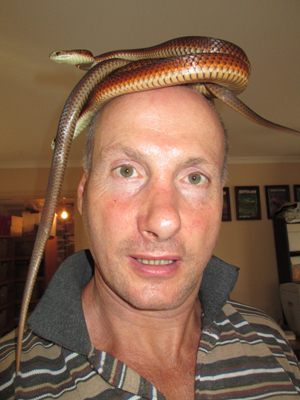Courses.
There are many providers of reptile handling courses of all manner on offer.
These include snake handler training and courses that teach people how to identify, capture, control, relocate, and handle dangerously venomous snakes. These snakes, known in Australia as elapids are also the most commonly seen snakes in most of the populated parts of Australia, although in tropical areas, non-venomous snakes are usually more commonly seen.
Included in south-eastern Australia are such well-known dangerous snakes as the Eastern Brown snake, red-bellied black snake, Mainland Tiger snake, Southern Death Adder, Lowlands and Highlands Copperheads and Coastal Taipans.
Most snake handler courses will give students at least a description of all the relevant species and others, so that they will be able to identify them at a glance and plan their capture accordingly.
However a few of the more basic courses don't get quite that far. Most course providers of reptile relocation. awareness, control and snake handler courses are actually relatively inexperienced themselves and in all probability shouldn't be teaching others how to handle snakes.
For reasons related to patronage and corruption, wildlife departments in several Australian states have dropped all checks and balances and issued course teaching permits to people with literally no experience with snakes whatsoever.
Because of this, a disproportionate number of graduates run off and get chomped by dangerous snakes shortly after completing such courses.
In recent years, Australia's snakebite rate has escalated and the number of deaths shot up from an average of 1.5 deaths a year to more than 6 a year, (nine in 2013, being a 20 year record for Australia), the majority of deaths being people who have recently completed accredited snake handler courses. In other words if you are going to complete a snake handling course in Australia to learn proper reptile identification, capture, control, handling, or husbandry it is suggested that you check the credentials of the teacher first. Don't worry about rogues who pay $2K to be able to claim RTO (Registered training organisation) status as this is meaningless in terms of how good the course actually is.
Likewise for those who claim to be the sole provider for a wildlife rescue organisation such as WIRES or similar.
Again you will find the provider has paid money for the privilidge to make this cvlaim and it has no bearing on their actual experience or the quality of the course training.
As a rule you will find that the better course providers do not need to pay money for recognition as such by irrelevant groups.
These providers will be known throughout Australia as reptile experts and cited as such in all the major texts and books on the subject.
The best test of expertise of any course provider is not their own company website, as this will always give a glowing testimonial, but rather to check the major books on Australian venomous snakes.
If your provider is cited and named within the book as an authority and expert, then you can be assured that your course teacher is an expert and knows his stuff. To that end, you find the name Raymond Hoser cited as a name authority in every major reptile book published in Australia in the lqast decade. In fact the Hoser name appears in books and scientific publications, globally, including Africa, Asia, South America, North America and New Guinea, due in part to the fact he has named more species of snake than anyone else alive.
On the other hand if your potential teacher is effectively unknown within professional herpetology, it is a safe bet that they are unknown for a reason and should not be dealt with. This is because a single mistake with a dangerously venomous snake can be fatal and there is no way you want to make one.
Thus it's way better to get it right the first time!
